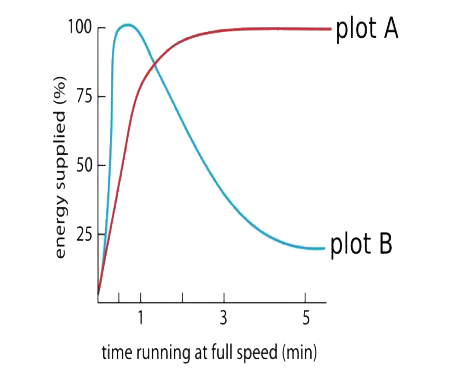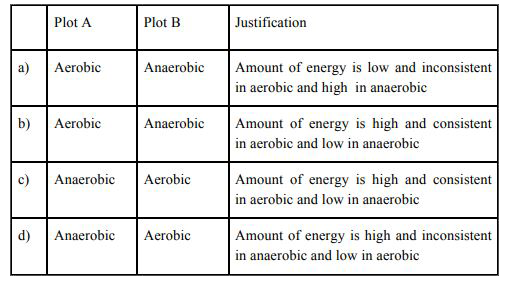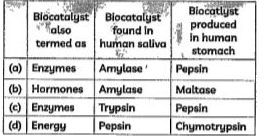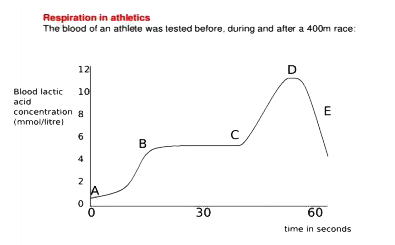All living cells require energy for various activities. This energy is available by the breakdown of simple carbohydrates either using oxygen or without using oxygen.
Study the graph below that represents the amount of energy supplied with respect to the time while an athlete is running at full speed.

Choose the correct combination of plots and justification provided in the following table.

The correct Answer is:B
Topper's Solved these Questions
- BOOK - CBSE MODEL PAPERCHAPTER - SAMPLE QUESTION PAPER 2020-21 (SCIENCE)EXERCISE - SECTION B9videos
SAMPLE QUESTION PAPER 2020-21 (SCIENCE)
- BOOK - CBSE MODEL PAPERCHAPTER - SAMPLE QUESTION PAPER 2020-21 (SCIENCE)EXERCISE - SECTION C7videos
SAMPLE QUESTION PAPER 2020-21 (SCIENCE)
- BOOK - CBSE MODEL PAPERCHAPTER - SAMPLE PAPER 2023 TERM IEXERCISE - SECTION-E3videos
SAMPLE PAPER 2023 TERM I
Similar Questions
Photosynthesis is the process by which autotrophs take in susbstances from the outside and convert take insubstances from the outside and convert them into stored formes of energy .the materials is taken in the form of carbon dioxide and water which is converted into carbohydrates in the presence of sunlight chlorophyll . The carbohydrates which are not used immediately are stores in the form of starch , which serves as the internal energy reserve to be used as and when required by the plant . The complex substances have to be broken down into simpler ones before they can be used for the unkeep and growth of the body .
Choose the correct combination of plots provided in the following table .
 View Solution
View SolutionAll living cells require energy for various activities. This energy is available by the breakdown of simple carbohydrates either using oxygen or without using oxygen.
The graph below represents the blood lactic acid concentration of an athlete during a race of 400 m and shows a peak at point D.

Lactic acid production has occurred in the athlete while running in the 400 m race. Which of the following processes explains this event?View Solution
Knowledge Check
- Question 1 - Select One
All living cells require energy for various activities. This energy is available by the breakdown of simple carbohydrates either using oxygen or without using oxygen.
Study the table below and select the row that has the incorrect information.AAerobic AnaerobicaLocation Cytoplasm MitochondriaBAerobic AnaerobicbEnd ProductCO2 and H20Ethanol andCO2CAerobic AnaerobiccAmount of ATP HighLowDAerobic AnaerobicdOxygen Needed Not needed - Question 2 - Select One
All living cells require energy for various activities. This energy is available by the breakdown of simple carbohydrates either using oxygen or without using oxygen.
Energy in the case of higher plants and animals is obtained byABreathingBTissue respirationCOrgan respirationDDigestion of food - Question 3 - Select One
All living cells require energy for various activities. This energy is available by the breakdown of simple carbohydrates either using oxygen or without using oxygen.
The characteristic processes observed in anaerobic respiration are
i) presence of oxygen
ii) release of carbon dioxide
iii) release of energy
iv) release of lactic acidAi) ,ii) onlyBi), ii), iii) onlyCii), iii), iv) onlyDiv) only
Read the passage given below and answer the question:
Adenosine triphosphate (ATP) is the energy-carrying molecule found in the cells of all living things. ATP captures chemical energy obtained from the breakdown of food molecules and releases it to fuel other cellular processes. ATP is a nucleotide that consists of three main structures: the nitrogenous base, adenine, the sugar, ribose, and a chain of three phosphate groups bound to ribose. The phosphate tail of ATP is the actual power source which the cell taps. Available energy is contained in the bonds between the phosphates and is released when they are broken, which occurs through the addition of a water molecule (a process called hydrolysis). Usually only the outer phosphate is removed from ATP to yield energy, when this occurs ATP is converted to adenosine diphosphate (ADP), the form of the nucleotide having only two phosphates.
The importance of ATP (adenosine triphosphate) as the main source of chemical energy in living matter and its involvement in cellular processes has long been recognized. The primary mechanism whereby higher organisms, including humans, generate ATP is through mitochondrial oxidative phosphorylation. For the majority of organs, the main metabolic fuel is glucose, which in the presence of oxygen undergoes complete combustion to CO2 and H2O:
C6H12O6+6O2→6CO2+6H2O+energy
The free energy (AG) liberated in this exergonic (AG is negative) reaction is partially trapped as ATP in two consecutive processes: glycolysis (cytosol) and oxidative phosphorylation (mitochondria). The first produces 2 mol of ATP per mol of glucose, and the second 36 mol of ATP per mol of glucose. Thus, oxidative phosphorylation yields 17-18 times as much useful energy in the form of ATP as can be obtained from the same amount of glucose by glycolysis alone.
The efficiency of glucose metabolism is the ratio of amount of energy produced when 1 mol of glucose oxidised in cell to the enthalpy of combustion of glucose. The energy lost in the process is in the form of heat. This heat is responsible for keeping us warm.
(source: Erecińska, M., & Silver, 1. A. (1989). ATP and Brain Function. Journal of Cerebral Blood Flow & Metabolism, 9(1), 2-19. https://doi.org/10.1038/jcbfm. 1989.2 and https://www.britannica.com/science/adenosine-triphosphate)
Which of the following statement is true?View SolutionRead the passage given below and answer the question:
Adenosine triphosphate (ATP) is the energy-carrying molecule found in the cells of all living things. ATP captures chemical energy obtained from the breakdown of food molecules and releases it to fuel other cellular processes. ATP is a nucleotide that consists of three main structures: the nitrogenous base, adenine, the sugar, ribose, and a chain of three phosphate groups bound to ribose. The phosphate tail of ATP is the actual power source which the cell taps. Available energy is contained in the bonds between the phosphates and is released when they are broken, which occurs through the addition of a water molecule (a process called hydrolysis). Usually only the outer phosphate is removed from ATP to yield energy, when this occurs ATP is converted to adenosine diphosphate (ADP), the form of the nucleotide having only two phosphates.
The importance of ATP (adenosine triphosphate) as the main source of chemical energy in living matter and its involvement in cellular processes has long been recognized. The primary mechanism whereby higher organisms, including humans, generate ATP is through mitochondrial oxidative phosphorylation. For the majority of organs, the main metabolic fuel is glucose, which in the presence of oxygen undergoes complete combustion to CO2 and H2O:
C6H12O6+6O2→6CO2+6H2O+energy
The free energy (AG) liberated in this exergonic (AG is negative) reaction is partially trapped as ATP in two consecutive processes: glycolysis (cytosol) and oxidative phosphorylation (mitochondria). The first produces 2 mol of ATP per mol of glucose, and the second 36 mol of ATP per mol of glucose. Thus, oxidative phosphorylation yields 17-18 times as much useful energy in the form of ATP as can be obtained from the same amount of glucose by glycolysis alone.
The efficiency of glucose metabolism is the ratio of amount of energy produced when 1 mol of glucose oxidised in cell to the enthalpy of combustion of glucose. The energy lost in the process is in the form of heat. This heat is responsible for keeping us warm.
(source: Erecińska, M., & Silver, 1. A. (1989). ATP and Brain Function. Journal of Cerebral Blood Flow & Metabolism, 9(1), 2-19. https://doi.org/10.1038/jcbfm. 1989.2 and https://www.britannica.com/science/adenosine-triphosphate)
What is the efficiency of glucose metabolism if 1 mole of glucose gives 38ATP energy?(Given: The enthalpy of combustion of glucose is 686 kcal, 1ATP= 7.3kcal)View SolutionRead the passage given below and answer the question:
Adenosine triphosphate (ATP) is the energy-carrying molecule found in the cells of all living things. ATP captures chemical energy obtained from the breakdown of food molecules and releases it to fuel other cellular processes. ATP is a nucleotide that consists of three main structures: the nitrogenous base, adenine, the sugar, ribose, and a chain of three phosphate groups bound to ribose. The phosphate tail of ATP is the actual power source which the cell taps. Available energy is contained in the bonds between the phosphates and is released when they are broken, which occurs through the addition of a water molecule (a process called hydrolysis). Usually only the outer phosphate is removed from ATP to yield energy, when this occurs ATP is converted to adenosine diphosphate (ADP), the form of the nucleotide having only two phosphates.
The importance of ATP (adenosine triphosphate) as the main source of chemical energy in living matter and its involvement in cellular processes has long been recognized. The primary mechanism whereby higher organisms, including humans, generate ATP is through mitochondrial oxidative phosphorylation. For the majority of organs, the main metabolic fuel is glucose, which in the presence of oxygen undergoes complete combustion to CO2 and H2O:
C6H12O6+6O2→6CO2+6H2O+energy
The free energy (AG) liberated in this exergonic (AG is negative) reaction is partially trapped as ATP in two consecutive processes: glycolysis (cytosol) and oxidative phosphorylation (mitochondria). The first produces 2 mol of ATP per mol of glucose, and the second 36 mol of ATP per mol of glucose. Thus, oxidative phosphorylation yields 17-18 times as much useful energy in the form of ATP as can be obtained from the same amount of glucose by glycolysis alone.
The efficiency of glucose metabolism is the ratio of amount of energy produced when 1 mol of glucose oxidised in cell to the enthalpy of combustion of glucose. The energy lost in the process is in the form of heat. This heat is responsible for keeping us warm.
(source: Erecińska, M., & Silver, 1. A. (1989). ATP and Brain Function. Journal of Cerebral Blood Flow & Metabolism, 9(1), 2-19. https://doi.org/10.1038/jcbfm. 1989.2 and https://www.britannica.com/science/adenosine-triphosphate)
Cellular oxidation of glucose is a:View SolutionRead the passage given below and answer the question:
Adenosine triphosphate (ATP) is the energy-carrying molecule found in the cells of all living things. ATP captures chemical energy obtained from the breakdown of food molecules and releases it to fuel other cellular processes. ATP is a nucleotide that consists of three main structures: the nitrogenous base, adenine, the sugar, ribose, and a chain of three phosphate groups bound to ribose. The phosphate tail of ATP is the actual power source which the cell taps. Available energy is contained in the bonds between the phosphates and is released when they are broken, which occurs through the addition of a water molecule (a process called hydrolysis). Usually only the outer phosphate is removed from ATP to yield energy, when this occurs ATP is converted to adenosine diphosphate (ADP), the form of the nucleotide having only two phosphates.
The importance of ATP (adenosine triphosphate) as the main source of chemical energy in living matter and its involvement in cellular processes has long been recognized. The primary mechanism whereby higher organisms, including humans, generate ATP is through mitochondrial oxidative phosphorylation. For the majority of organs, the main metabolic fuel is glucose, which in the presence of oxygen undergoes complete combustion to CO2 and H2O:
C6H12O6+6O2→6CO2+6H2O+energy
The free energy (AG) liberated in this exergonic (AG is negative) reaction is partially trapped as ATP in two consecutive processes: glycolysis (cytosol) and oxidative phosphorylation (mitochondria). The first produces 2 mol of ATP per mol of glucose, and the second 36 mol of ATP per mol of glucose. Thus, oxidative phosphorylation yields 17-18 times as much useful energy in the form of ATP as can be obtained from the same amount of glucose by glycolysis alone.
The efficiency of glucose metabolism is the ratio of amount of energy produced when 1 mol of glucose oxidised in cell to the enthalpy of combustion of glucose. The energy lost in the process is in the form of heat. This heat is responsible for keeping us warm.
(source: Erecińska, M., & Silver, 1. A. (1989). ATP and Brain Function. Journal of Cerebral Blood Flow & Metabolism, 9(1), 2-19. https://doi.org/10.1038/jcbfm. 1989.2 and https://www.britannica.com/science/adenosine-triphosphate)
Nearly 95% of the energy released during cellular respiration is due to:View SolutionRead the passage given below and answer the question:
Adenosine triphosphate (ATP) is the energy-carrying molecule found in the cells of all living things. ATP captures chemical energy obtained from the breakdown of food molecules and releases it to fuel other cellular processes. ATP is a nucleotide that consists of three main structures: the nitrogenous base, adenine, the sugar, ribose, and a chain of three phosphate groups bound to ribose. The phosphate tail of ATP is the actual power source which the cell taps. Available energy is contained in the bonds between the phosphates and is released when they are broken, which occurs through the addition of a water molecule (a process called hydrolysis). Usually only the outer phosphate is removed from ATP to yield energy, when this occurs ATP is converted to adenosine diphosphate (ADP), the form of the nucleotide having only two phosphates.
The importance of ATP (adenosine triphosphate) as the main source of chemical energy in living matter and its involvement in cellular processes has long been recognized. The primary mechanism whereby higher organisms, including humans, generate ATP is through mitochondrial oxidative phosphorylation. For the majority of organs, the main metabolic fuel is glucose, which in the presence of oxygen undergoes complete combustion to CO2 and H2O:
C6H12O6+6O2→6CO2+6H2O+energy
The free energy (AG) liberated in this exergonic (AG is negative) reaction is partially trapped as ATP in two consecutive processes: glycolysis (cytosol) and oxidative phosphorylation (mitochondria). The first produces 2 mol of ATP per mol of glucose, and the second 36 mol of ATP per mol of glucose. Thus, oxidative phosphorylation yields 17-18 times as much useful energy in the form of ATP as can be obtained from the same amount of glucose by glycolysis alone.
The efficiency of glucose metabolism is the ratio of amount of energy produced when 1 mol of glucose oxidised in cell to the enthalpy of combustion of glucose. The energy lost in the process is in the form of heat. This heat is responsible for keeping us warm.
(source: Erecińska, M., & Silver, 1. A. (1989). ATP and Brain Function. Journal of Cerebral Blood Flow & Metabolism, 9(1), 2-19. https://doi.org/10.1038/jcbfm. 1989.2 and https://www.britannica.com/science/adenosine-triphosphate)
Which of the following statements is correct:View Solution


